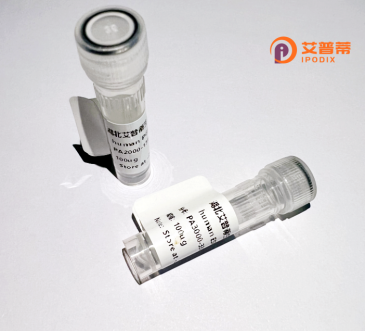
| 纯度 | >90%SDS-PAGE. |
| 种属 | Human |
| 靶点 | CCDC103 |
| Uniprot No | Q8IW40 |
| 内毒素 | < 0.01EU/μg |
| 表达宿主 | E.coli |
| 表达区间 | 1-242aa |
| 氨基酸序列 | MERNDIINFKALEKELQAALTADEKYKRENAAKLRAVEQRVASYEEFRGIVLASHLKPLERKDKMGGKRTVPWNCHTIQGRTFQDVATEISPEKAPLQPETSADFYRDWRRHLPSGPERYQALLQLGGPRLGCLFQTDVGFGLLGELLVALADHVGPADRAAVLGILCSLASTGRFTLNLSLLSRAERESCKGLFQKLQAMGNPRSVKEGLSWEEQGLEEQSGGLQEEERLLQELLELYQVD |
| 分子量 | 53.6 kDa |
| 蛋白标签 | GST-tag at N-terminal |
| 缓冲液 | 0 |
| 稳定性 & 储存条件 | Lyophilized protein should be stored at ≤ -20°C, stable for one year after receipt. Reconstituted protein solution can be stored at 2-8°C for 2-7 days. Aliquots of reconstituted samples are stable at ≤ -20°C for 3 months. |
| 复溶 | Always centrifuge tubes before opening.Do not mix by vortex or pipetting. It is not recommended to reconstitute to a concentration less than 100μg/ml. Dissolve the lyophilized protein in distilled water. Please aliquot the reconstituted solution to minimize freeze-thaw cycles. |
以下是关于CCDC103的3篇代表性文献,涵盖其在纤毛功能、生殖及结构机制中的研究:
---
1. **"Mutations in CCDC103 cause primary ciliary dyskinesia by disrupting assembly of the dynein arms"**
- **作者**: Panizzi JR, Becker-Heck A, Castleman VH, et al.
- **摘要**: 本研究首次将CCDC103突变与原发性纤毛运动障碍(PCD)关联,发现其通过破坏纤毛轴丝中动力蛋白臂的组装,导致纤毛运动异常,并利用斑马鱼模型验证了功能缺失表型。
2. **"CCDC103 is required for sperm flagellar beating and male fertility in mice"**
- **作者**: King SM, Patel-King RS
- **摘要**: 通过基因敲除小鼠模型,揭示CCDC103对精子鞭毛的波浪式运动至关重要,其缺失导致精子活力丧失及雄性不育,强调其在轴丝结构完整性中的作用。
3. **"Structural and functional analysis of CCDC103’s role in the dynein regulatory complex"**
- **作者**: Horani A, Ferkol TW, Shoseyov D, et al.
- **摘要**: 结合生化与结构研究,阐明CCDC103的卷曲螺旋结构域与动力蛋白调节复合物(DRC)相互作用,维持纤毛搏动的协调性,突变可导致呼吸道症状和PCD。
---
这些研究共同揭示了CCDC103在纤毛组装和运动中的关键作用,及其突变在疾病发生中的机制。
Coiled-coil domain-containing protein 103 (CCDC103) is a gene-encoded protein highly conserved across vertebrates, primarily localized in cilia and flagella. It plays a critical role in ciliary structure and function, particularly in regulating dynein-mediated motility and cilia assembly. CCDC103 contains tandem coiled-coil domains, enabling it to form stable oligomers and interact with radial spoke proteins and dynein arms, which are essential for proper ciliary beating and fluid movement. Mutations in CCDC103 are linked to primary ciliary dyskinesia (PCD), a genetic disorder characterized by impaired mucociliary clearance, leading to chronic respiratory infections, situs inversus, and infertility. Studies using knockout models reveal that CCDC103 deficiency disrupts cilia ultrastructure, compromising their motility and physiological functions. Additionally, CCDC103 is implicated in cancer progression, with dysregulated expression observed in malignancies like lung adenocarcinoma and gliomas, potentially influencing metastasis. Research continues to explore its regulatory mechanisms, including interactions with other ciliary proteins like DNAH5 and its post-translational modifications. As a biomarker, CCDC103 holds diagnostic potential for PCD and cilia-related syndromes. Its dual roles in ciliogenesis and disease pathways highlight its importance in both basic biology and clinical research.
×